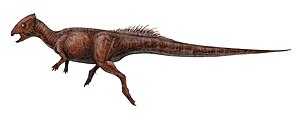Homalocephale
| Homalocephale | ||||||||||||
|---|---|---|---|---|---|---|---|---|---|---|---|---|

Live reconstruction of homalocephale |
||||||||||||
| Temporal occurrence | ||||||||||||
| Upper Cretaceous (late Campanium to possibly early Maastrichtian ) | ||||||||||||
| 76.4 to 69.9 million years | ||||||||||||
| Locations | ||||||||||||
| Systematics | ||||||||||||
|
||||||||||||
| Scientific name | ||||||||||||
| Homalocephale | ||||||||||||
| Maryańska & Osmólska , 1974 |
Homalocephale is a genus of the bird pelvic dinosaur (Ornithischia) from the group of the Pachycephalosauria . He was one of the flat-headed representatives of this group, at the same time he is one of the most fully preserved pachycephalosaurs. The only species described is H. calathocercos .
features
Homalocephale reached a length of around 3 meters and is therefore one of the medium-sized pachycephalosaurs. Like all representatives of this group, this dinosaur had a noticeably thickened skull roof, which was formed from the frontal bone and the parietal bone . He is one of the flat-headed representatives of this group, in whom the skull roof was not arched, the skull sutures were visible and the upper skull window of the temporal region was well developed. For assumptions about the function of this skullcap, see Function of the skullcap in the Pachycephalosauria . There were also small bony bumps on the sides and back of the skull. The preserved teeth of the upper jaw were small and had triangular crowns. Like all pachycephalosaurs, Homalocephale probably had a predominantly vegetable diet, possibly supplemented by insects.
In contrast to most other pachycephalosaurs, the trunk skeleton is also well preserved. The trunk was relatively stocky, the vertebrae were reinforced by interlocking connections, the sacral vertebrae that had grown together to form the sacrum had long ribs (sacral ribs). The anterior caudal vertebrae were also equipped with ribs, the posterior caudal vertebrae were stiffened by chevron bones (V-shaped appendages on the underside) and ossified tendons . The pool was very broad; the hind legs were long and suggest that this dinosaur was able to move relatively quickly.
Discovery and naming
The fossil remains of Homalocephale were discovered in the Mongolian province of Ömnö-Gobi-Aimag and first described in 1974; other finds come from the Chinese province of Tibet . The generic name is derived from the Greek words homalos (= "equal") and kephalē (= "head"), a common part of the name of pachycephalosaurs. The type and only known species is H. calathocercos . The finds are dated in the Upper Cretaceous (late Campanium or early Maastrichtian ) to an age of around 76 to 69 million years.
Systematics
Traditionally, Homalocephale was incorporated within the Pachycephalosauria into the Homalocephalidae, the group of primitive, flat-headed representatives who were named after this dinosaur and who faced the dome-headed, more highly developed Pachycephalosauridae. The "Homalocephalidae" are now considered to be paraphyletic , so they do not represent a natural family group, as the Pachycephalosauridae evolved from them. A cladistic study by T. Maryańska et al. sees Homalocephale as a relatively primitive representative of the Pachycephalosauria. However, with the discovery of Dracorex , a flat-headed but highly developed pachycephalosaur, the internal system was shaken. According to R. Sullivan, it is also conceivable that the development from dome-headed to flat-headed animals took place, so that the flat skull is the derived characteristic.
literature
- Teresa Maryańska , Ralph E. Chapman, David B. Weishampel : Pachycephalosauria. In: David B. Weishampel, Peter Dodson , Halszka Osmólska (eds.): The Dinosauria . 2nd edition. University of California Press, Berkeley CA et al. 2004, ISBN 0-520-24209-2 , pp. 464-477.
- Robert M. Sullivan: A taxonomic review of the Pachycephalosauridae (Dinosauria: Ornithischia). In: Spencer G. Lucas, Robert M. Sullivan (Eds.): Late Cretaceous Vertebrates from the Western Interior (= New Mexico Museum of Natural History and Science. Bulletin. 35, ISSN 1524-4156 ). New Mexico Museum of Natural History and Science, Albuquerque NM 2006, pp. 347–365, digital version (PDF; 4.79 MB) .
Individual evidence
- ^ Gregory S. Paul : The Princeton Field Guide To Dinosaurs. Princeton University Press, Princeton NJ et al. 2010, ISBN 978-0-691-13720-9 , p. 244, online ( memento of the original of July 13, 2015 in the Internet Archive ) Info: The archive link was inserted automatically and has not yet been checked. Please check the original and archive link according to the instructions and then remove this notice. .